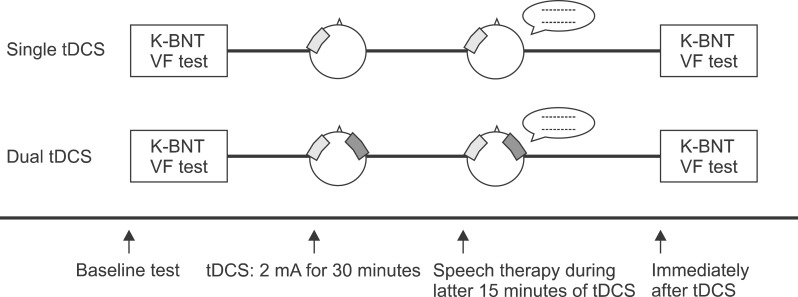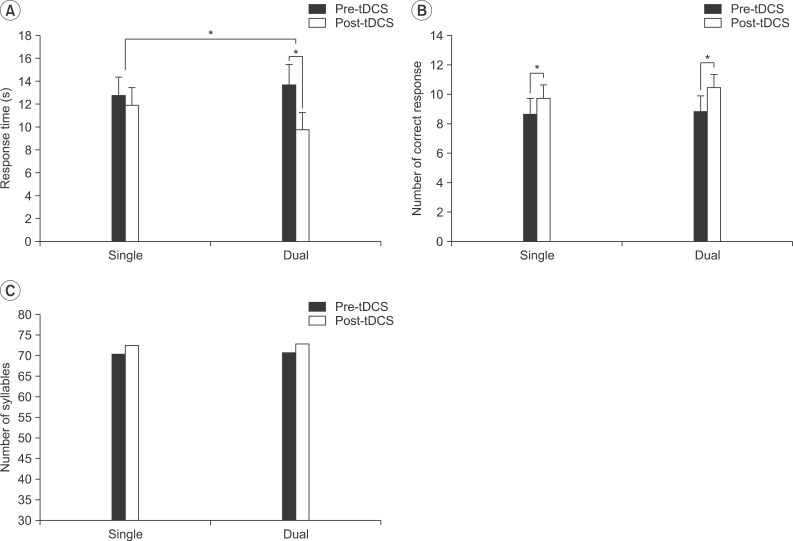Ann Rehabil Med.
2013 Oct;37(5):603-610. 10.5535/arm.2013.37.5.603.
Effects of Dual Transcranial Direct Current Stimulation for Aphasia in Chronic Stroke Patients
- Affiliations
-
- 1Department of Physical and Rehabilitation Medicine, Stroke and Cerebrovascular Center, Samsung Medical Center, Seoul, Korea. yunkim@skku.edu
- 2Department of Physical and Rehabilitation Medicine, Kangbuk Samsung Hospital, Sungkyunkwan University School of Medicine, Seoul, Korea.
- KMID: 2266576
- DOI: http://doi.org/10.5535/arm.2013.37.5.603
Abstract
OBJECTIVE
To investigate any additional effect of dual transcranial direct current stimulation (tDCS) compared with single tDCS in chronic stroke patients with aphasia.
METHODS
Eleven chronic stroke patients (aged 52.6+/-13.4 years, nine men) with aphasia were enrolled. Single anodal tDCS was applied over the left inferior frontal gyrus (IFG) and a cathodal electrode was placed over the left buccinator muscle. Dual tDCS was applied as follows: 1) anodal tDCS over the left IFG and cathodal tDCS over the left buccinator muscle and 2) cathodal tDCS over the right IFG and anodal tDCS over the right buccinator muscle. Each tDCS was delivered for 30 minutes at a 2-mA intensity. Speech therapy was provided during the last 15 minutes of the tDCS. Before and after the stimulation, the Korean-Boston Naming Test and a verbal fluency test were performed.
RESULTS
The dual tDCS produced a significant improvement in the response time for the Korean-Boston Naming Test compared with the baseline assessment, with a significant interaction between the time and type of interventions. Both single and dual tDCS produced a significant improvement in the number of correct responses after stimulation with no significant interaction. No significant changes in the verbal fluency test were observed after single or dual tDCS.
CONCLUSION
The results conveyed that dual tDCS using anodal tDCS over the left IFG and cathodal tDCS over the right IFG may be more effective than a single anodal tDCS over the left IFG.
MeSH Terms
Figure
Reference
-
1. Jordan LC, Hillis AE. Disorders of speech and language: aphasia, apraxia and dysarthria. Curr Opin Neurol. 2006; 19:580–585. PMID: 17102697.
Article2. Nicholas ML, Helm-Estabrooks N, Ward-Lonergan J, Morgan AR. Evolution of severe aphasia in the first two years post onset. Arch Phys Med Rehabil. 1993; 74:830–836. PMID: 7688503.
Article3. Robey RR. The efficacy of treatment for aphasic persons: a meta-analysis. Brain Lang. 1994; 47:582–608. PMID: 7859056.
Article4. Robey RR. A meta-analysis of clinical outcomes in the treatment of aphasia. J Speech Lang Hear Res. 1998; 41:172–187. PMID: 9493743.
Article5. Nitsche MA, Paulus W. Excitability changes induced in the human motor cortex by weak transcranial direct current stimulation. J Physiol. 2000; 527:633–639. PMID: 10990547.
Article6. Priori A, Berardelli A, Rona S, Accornero N, Manfredi M. Polarization of the human motor cortex through the scalp. Neuroreport. 1998; 9:2257–2260. PMID: 9694210.
Article7. Liebetanz D, Nitsche MA, Tergau F, Paulus W. Pharmacological approach to the mechanisms of transcranial DC-stimulation-induced after-effects of human motor cortex excitability. Brain. 2002; 125:2238–2247. PMID: 12244081.
Article8. Fregni F, Boggio PS, Nitsche M, Bermpohl F, Antal A, Feredoes E, et al. Anodal transcranial direct current stimulation of prefrontal cortex enhances working memory. Exp Brain Res. 2005; 166:23–30. PMID: 15999258.
Article9. Sparing R, Dafotakis M, Meister IG, Thirugnanasambandam N, Fink GR. Enhancing language performance with non-invasive brain stimulation: a transcranial direct current stimulation study in healthy humans. Neuropsychologia. 2008; 46:261–268. PMID: 17804023.10. Baker JM, Rorden C, Fridriksson J. Using transcranial direct-current stimulation to treat stroke patients with aphasia. Stroke. 2010; 41:1229–1236. PMID: 20395612.
Article11. Fertonani A, Rosini S, Cotelli M, Rossini PM, Miniussi C. Naming facilitation induced by transcranial direct current stimulation. Behav Brain Res. 2010; 208:311–318. PMID: 19883697.
Article12. Fridriksson J, Richardson JD, Baker JM, Rorden C. Transcranial direct current stimulation improves naming reaction time in fluent aphasia: a double-blind, sham-controlled study. Stroke. 2011; 42:819–821. PMID: 21233468.13. Karbe H, Thiel A, Weber-Luxenburger G, Herholz K, Kessler J, Heiss WD. Brain plasticity in poststroke aphasia: what is the contribution of the right hemisphere? Brain Lang. 1998; 64:215–230. PMID: 9710490.
Article14. Lotze M, Markert J, Sauseng P, Hoppe J, Plewnia C, Gerloff C. The role of multiple contralesional motor areas for complex hand movements after internal capsular lesion. J Neurosci. 2006; 26:6096–6102. PMID: 16738254.
Article15. Loubinoux I, Carel C, Pariente J, Dechaumont S, Albucher JF, Marque P, et al. Correlation between cerebral reorganization and motor recovery after subcortical infarcts. Neuroimage. 2003; 20:2166–2180. PMID: 14683720.
Article16. Kang EK, Kim YK, Sohn HM, Cohen LG, Paik NJ. Improved picture naming in aphasia patients treated with cathodal tDCS to inhibit the right Broca's homologue area. Restor Neurol Neurosci. 2011; 29:141–152. PMID: 21586821.
Article17. You DS, Kim DY, Chun MH, Jung SE, Park SJ. Cathodal transcranial direct current stimulation of the right Wernicke's area improves comprehension in subacute stroke patients. Brain Lang. 2011; 119:1–5. PMID: 21641021.
Article18. Vines BW, Cerruti C, Schlaug G. Dual-hemisphere tDCS facilitates greater improvements for healthy subjects' non-dominant hand compared to uni-hemisphere stimulation. BMC Neurosci. 2008; 9:103. PMID: 18957075.
Article19. Giglia G, Mattaliano P, Puma A, Rizzo S, Fierro B, Brighina F. Neglect-like effects induced by tDCS modulation of posterior parietal cortices in healthy subjects. Brain Stimul. 2011; 4:294–299. PMID: 22032745.20. Nitsche MA, Cohen LG, Wassermann EM, Priori A, Lang N, Antal A, et al. Transcranial direct current stimulation: state of the art 2008. Brain Stimul. 2008; 1:206–223. PMID: 20633386.
Article21. Okamoto M, Dan H, Sakamoto K, Takeo K, Shimizu K, Kohno S, et al. Three-dimensional probabilistic anatomical cranio-cerebral correlation via the international 10-20 system oriented for transcranial functional brain mapping. Neuroimage. 2004; 21:99–111. PMID: 14741647.
Article22. Galea JM, Jayaram G, Ajagbe L, Celnik P. Modulation of cerebellar excitability by polarity-specific noninvasive direct current stimulation. J Neurosci. 2009; 29:9115–9122. PMID: 19605648.
Article23. Kim H, Na DL. Normative data on the Korean version of the Boston Naming Test. J Clin Exp Neuropsychol. 1999; 21:127–133. PMID: 10421007.24. Kim H, Na DL. Normative data on the Korean version of the Western Aphasia Battery. J Clin Exp Neuropsychol. 2004; 26:1011–1020. PMID: 15590457.
Article25. Heiss WD, Kessler J, Thiel A, Ghaemi M, Karbe H. Differential capacity of left and right hemispheric areas for compensation of poststroke aphasia. Ann Neurol. 1999; 45:430–438. PMID: 10211466.
Article26. Heiss WD, Thiel A. A proposed regional hierarchy in recovery of post-stroke aphasia. Brain Lang. 2006; 98:118–123. PMID: 16564566.
Article27. Fridriksson J, Bonilha L, Baker JM, Moser D, Rorden C. Activity in preserved left hemisphere regions predicts anomia severity in aphasia. Cereb Cortex. 2010; 20:1013–1019. PMID: 19687294.
Article28. Warburton E, Price CJ, Swinburn K, Wise RJ. Mechanisms of recovery from aphasia: evidence from positron emission tomography studies. J Neurol Neurosurg Psychiatry. 1999; 66:155–161. PMID: 10071093.
Article29. Rosen HJ, Petersen SE, Linenweber MR, Snyder AZ, White DA, Chapman L, et al. Neural correlates of recovery from aphasia after damage to left inferior frontal cortex. Neurology. 2000; 55:1883–1894. PMID: 11134389.
Article30. Saur D, Lange R, Baumgaertner A, Schraknepper V, Willmes K, Rijntjes M, et al. Dynamics of language reorganization after stroke. Brain. 2006; 129:1371–1384. PMID: 16638796.
Article31. Floel A, Meinzer M, Kirstein R, Nijhof S, Deppe M, Knecht S, et al. Short-term anomia training and electrical brain stimulation. Stroke. 2011; 42:2065–2067. PMID: 21636820.
Article32. Murase N, Duque J, Mazzocchio R, Cohen LG. Influence of interhemispheric interactions on motor function in chronic stroke. Ann Neurol. 2004; 55:400–409. PMID: 14991818.
Article33. Shimizu T, Hosaki A, Hino T, Sato M, Komori T, Hirai S, et al. Motor cortical disinhibition in the unaffected hemisphere after unilateral cortical stroke. Brain. 2002; 125:1896–1907. PMID: 12135979.
Article34. Schlaug G, Renga V, Nair D. Transcranial direct current stimulation in stroke recovery. Arch Neurol. 2008; 65:1571–1576. PMID: 19064743.
Article
- Full Text Links
- Actions
-
Cited
- CITED
-
- Close
- Share
- Similar articles
-
- Current Evidence for Post Stroke Aphasia Treatment
- Application of Non-invasive Brain Stimulation on Dysphagia after Stroke
- The Factors Associated with Good Responses to Speech Therapy Combined with Transcranial Direct Current Stimulation in Post-stroke Aphasic Patients
- Current Approaches to the Treatment of Post-Stroke Aphasia
- Non-Invasive Brain Stimulation for Treatment of Focal Hand Dystonia: Update and Future Direction



